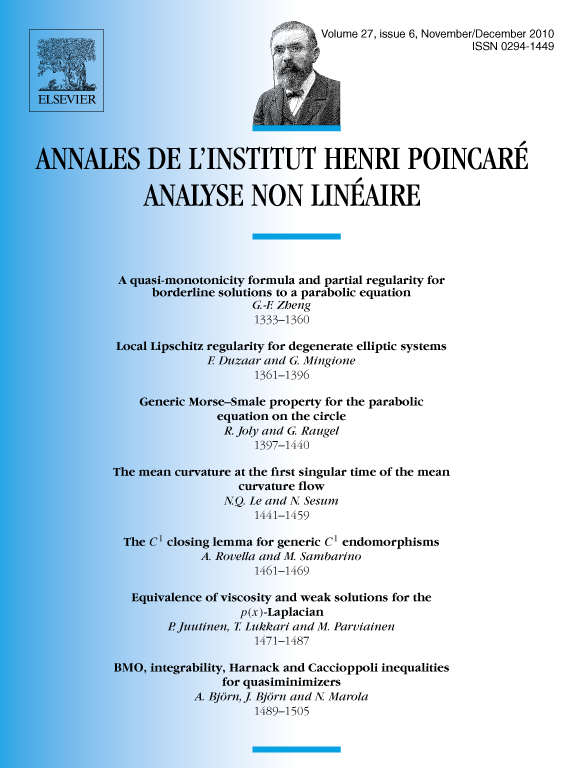Generic Morse–Smale property for the parabolic equation on the circle
Romain Joly
Institut Fourier, 100 rue des Maths, BP 74, F-38402 St-Martin-d'Hères, FranceGeneviève Raugel
CNRS, Laboratoire de Mathématiques d'Orsay; Université Paris-Sud, F-91405 Orsay cedex, France

Abstract
In this paper, we show that, for scalar reaction–diffusion equations on the circle , the Morse–Smale property is generic with respect to the non-linearity . In Czaja and Rocha (2008) [13], Czaja and Rocha have proved that any connecting orbit, which connects two hyperbolic periodic orbits, is transverse and that there does not exist any homoclinic orbit, connecting a hyperbolic periodic orbit to itself. In Joly and Raugel (2010) [31], we have shown that, generically with respect to the non-linearity , all the equilibria and periodic orbits are hyperbolic. Here we complete these results by showing that any connecting orbit between two hyperbolic equilibria with distinct Morse indices or between a hyperbolic equilibrium and a hyperbolic periodic orbit is automatically transverse. We also show that, generically with respect to , there does not exist any connection between equilibria with the same Morse index. The above properties, together with the existence of a compact global attractor and the Poincaré–Bendixson property, allow us to deduce that, generically with respect to , the non-wandering set consists in a finite number of hyperbolic equilibria and periodic orbits. The main tools in the proofs include the lap number property, exponential dichotomies and the Sard–Smale theorem. The proofs also require a careful analysis of the asymptotic behavior of solutions of the linearized equations along the connecting orbits.
Résumé
Dans cet article, nous démontrons qu'il existe un ensemble générique de non-linéarités pour lesquelles les équations de réaction-diffusion , sur le cercle , ont la propriété de Morse–Smale. Dans Czaja et Rocha (2008) [13], Czaja et Rocha avaient montré que toute connexion entre deux orbites périodiques hyperboliques est transverse et qu'il n'existe pas d'orbite homocline à une orbite périodique hyperbolique. Dans Joly et Raugel (2010) [31], nous avons démontré qu'il existe un ensemble générique de non-linéarités pour lesquelles tous les points d'équilibre et toutes les orbites périodiques sont hyperboliques. Dans ce travail, nous prouvons que toute connexion entre deux points d'équilibre hyperboliques d'indices de Morse distincts ou entre un point d'équilibre et une orbite périodique hyperboliques est transverse. Nous montrons également qu'il existe un ensemble générique de non-linéarités pour lesquelles il n'existe pas de connexions entre points d'équilibre ayant même indice de Morse. Grâce à la propriété de Poincaré–Bendixson, nous déduisons des propriétés ci-dessus et de l'existence d'un attracteur global compact que, génériquement en la non-linéarité , l'ensemble non-errant se réduit à un nombre fini de points d'équilibre et d'orbites périodiques hyperboliques. Dans nos démonstrations, les propriétés du nombre de zéros, les dichotomies exponentielles, le comportement asymptotique des solutions des équations linéarisées et évidemment le théorème de Sard–Smale jouent un rôle crucial.
Cite this article
Romain Joly, Geneviève Raugel, Generic Morse–Smale property for the parabolic equation on the circle. Ann. Inst. H. Poincaré Anal. Non Linéaire 27 (2010), no. 6, pp. 1397–1440
DOI 10.1016/J.ANIHPC.2010.09.001